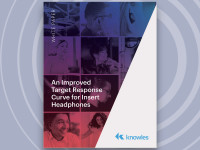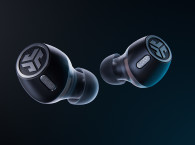
Knowles Corporation is a leading global provider of advanced micro-acoustic microphones and speakers, including solutions for hearing health acoustics, and understands how sound quality continues to be at the top of the list for consumer audio demand. Yet many manufacturers on in-earphones (wired and wireless) have been slow to take advantage of the developing hi-res audio ecosystem.
With the proliferation of lossless music streaming quality available through subscription services like Tidal, Amazon Music HD and Apple Music, together with availability of high data rate, improved Bluetooth codecs, the industry is now able to deliver hi-res audio wirelessly with the right hardware and tuning. Knowles' latest research provides valuable insight into how to satisfy consumer demand for the best-sounding audio in either wired or wireless in-earphones.
As the Knowles research describes in its introduction, the Harman earphone target response curve has been widely used to guide the design of earphones (in-ears), yet the studies on which it was based did not properly cover the full audible spectrum. This curve, first proposed in 2013, was based on research by Sean Olive and his team to find the curve that listeners liked best. Headphones with a response curve similar to this target consistently received the highest ratings from listeners in carefully controlled listening tests. However, Olive stated that the results were really only valid below 10kHz due to limitations of his test methods and available earphone test couplers.
Knowles analyzed more than 200 recordings, chosen from the last 20 years of the Billboard Hot 100 to represent much of the music that headphone wearers are likely to be streaming. This revealed significant high frequency content above 10kHz in popular music that many earphones fail to reproduce well. From here, the team conducted carefully controlled blind testing of a wide variety of listeners – with a range of demographics and hearing abilities – to determine what makes the best sound quality, as preferred by listeners.

Optimum high frequency response is key when designing hi-res earphones. Using technology only recently available, Knowles was able, for the first time, to extend an understanding of user preference beyond 10kHz to create the new Knowles Preferred Listening Response Curve. By focusing on the high frequency response, the new curve is uniquely suited to give manufacturers the insight needed to deliver the best hi-res listening experience.
Key findings from the Knowles research shows that earphones tuned to earlier concepts of what sounds good severely understate the amount of high frequency energy that listeners prefer. According to the Knowles Preferred Listening Response Curve, listeners consistently preferred between 12 and 21 decibels (dB) of boost at frequencies beyond 10KHz, depending on age and hearing ability. Designing and tuning an earphone that matches the high frequency boost identified using the Knowles Preferred Listening Response Curve is expected to consistently provide a highly satisfactory end user experience and receive high ratings from consumers.
The Knowles Curve is an especially powerful tool when used with hearing personalization algorithms. Knowles included subjects with various levels of reduced high frequency hearing response and determined their preferred amount of boost. With this data, designers of TWS earphones with hearing personalization can configure their algorithm to produce the optimum sound quality across the range of hearing abilities commonly experienced by consumers.

A Knowles Preferred Listening Response Curve whitepaper with suggestions on hardware to meet the new curve can be downloaded here. This research was first presented at the AES Chicago Chapter Meeting on May 17, 2022. Knowles will also release a new true wireless stereo (TWS) reference design tuned to the Knowles Curve, available in Q3 2022.
www.knowles.com








